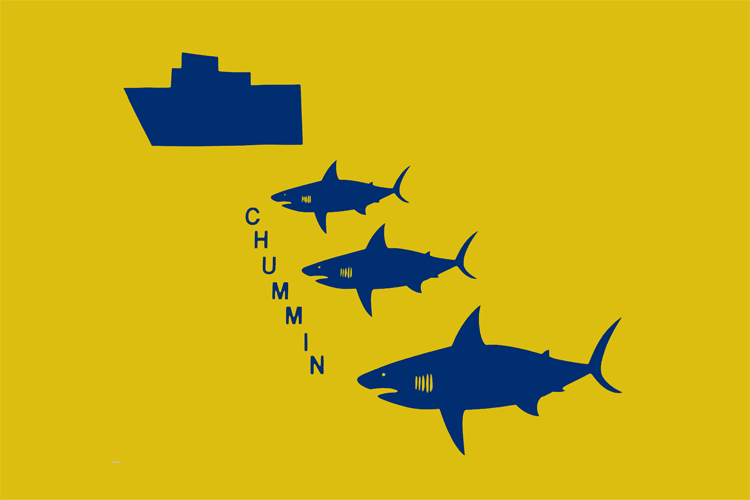The chumming flag was created in March 1997 from a simple question asked by a caller to "Let's Talk Hookup," a call-in fishing radio program in San Diego, California.
The caller asked, "How can you tell when a boat is chumming?"
The answer was, "Look for the sheen on the water. It might look like a current break."
I grew up in Imperial Beach, a beach town in Southern California.
It created my love for the ocean and the environment through fishing, bodysurfing, and snorkeling.
As a result, I began working at a bait and tackle shop, where my passion for fishing grew deeper.
So, when I heard the chumming question over the radio, I quickly thought of a solution - to create a chumming flag to inform others that chum/burley was in use.

Ethical Chumming
But what is chumming?
Chumming, also known as chunking, is the practice of throwing fresh pieces of bait fish with blood and bone overboard to attract marine animals.
Sportfishing boats have the problem of boats running up and poaching from their chumming of live bait, which shuts off the bite for everyone.
Therefore, a chumming flag could promote water ethics by establishing a courtesy zone to prevent any issues.
I went to work on creating a chumming flag. I applied for and was granted the copyright.
Soon after, my wife and I began making flags on our back patio that I would bring to local tackle shops, thus creating our small flag business.
A year later, I set up my first booth at the Day at the Docks festival and found that many people loved the chumming flag.
However, I needed to put the business on hold due to some issues.
I then offered the idea to a fishing organization to have them adopt and raise money for their programs.
Unfortunately, after discussing my offer, I was informed that they liked the idea but chose to pass on the offer.
Fast forward to 2014, while watching a fishing show, I noticed that fishermen were still complaining about the same problem: other boats getting too close while chumming.
It gave me the confidence to restart the business through an email campaign.
An Official SOLAS Flag
In 2015, Marie Lavine, the founder and executive director of the Shark Research Institute (SRI), supported the chumming flag and saw the value that a flag of this nature would bring from a safety standpoint.
Shortly after, other organizations and magazine outlets such as Fishyology (Malaysia), Feike (South Africa), and Sharknewz (Australia), along with others from around the world, offered their support for this endeavor.
We wanted to establish a code flag for chumming in an effort to reduce shark accidents globally while promoting sportsmanship among anglers.
In some parts of the world, chumming is illegal because it conditions sharks to associate feeding with human presence.
The chumming flag's goal is also to help generate revenue for the marine environment.
The endgame is having the International Maritime Organization (IMO) adopt an official code flag for chumming under SOLAS (Safety Of Life At Sea), the same as the two dive flags.
Flags have been used for centuries as a means of communication, so I hope to continue this tradition by establishing one more official flag.
Until then, enjoy your time on the water, and if you're going to chum, tell someone.
Words by Gerald Taggart | Creator of the Chumming Flag
